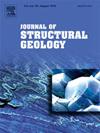Integration of deformed objects into a composite object analogous to the strain ellipse: a novel graphic method of Rf/ϕ strain analysis
IF 2.9
2区 地球科学
Q2 GEOSCIENCES, MULTIDISCIPLINARY
引用次数: 0
Abstract
The composite object of post-strain elliptical objects is defined as having a radial length that is the square root of the normalized sum of the squared radial lengths of the objects. It proves analogous to the strain ellipse and makes Rf/ϕ strain analysis simple. The finite strain is estimated from the overall shape of the composite object. The discrepancy between the composite object and the estimated strain ellipse is used to appraise the assumption of the uniformly distributed major axes of pre-strain objects. Two strain methods, direct calculation and numerical estimation, are developed to determine the strain from the composite object. Synthetic and natural datasets are used to validate the methods.
将变形对象集成为类似于应变椭圆的复合对象:一种新的Rf/ϕ应变分析图形方法
定义应变后椭圆物体的复合物体的径向长度为物体径向长度平方和的平方根。它被证明类似于应变椭圆,使Rf/ϕ应变分析简单。有限应变由复合物体的整体形状估计。利用复合物体与估计应变椭圆之间的差异来评价预应变物体长轴均匀分布的假设。本文提出了直接计算应变和数值估计应变两种方法来确定复合物体的应变。使用合成和自然数据集来验证方法。
本文章由计算机程序翻译,如有差异,请以英文原文为准。
求助全文
约1分钟内获得全文
求助全文
来源期刊

Journal of Structural Geology
地学-地球科学综合
CiteScore
6.00
自引率
19.40%
发文量
192
审稿时长
15.7 weeks
期刊介绍:
The Journal of Structural Geology publishes process-oriented investigations about structural geology using appropriate combinations of analog and digital field data, seismic reflection data, satellite-derived data, geometric analysis, kinematic analysis, laboratory experiments, computer visualizations, and analogue or numerical modelling on all scales. Contributions are encouraged to draw perspectives from rheology, rock mechanics, geophysics,metamorphism, sedimentology, petroleum geology, economic geology, geodynamics, planetary geology, tectonics and neotectonics to provide a more powerful understanding of deformation processes and systems. Given the visual nature of the discipline, supplementary materials that portray the data and analysis in 3-D or quasi 3-D manners, including the use of videos, and/or graphical abstracts can significantly strengthen the impact of contributions.
 求助内容:
求助内容: 应助结果提醒方式:
应助结果提醒方式:


